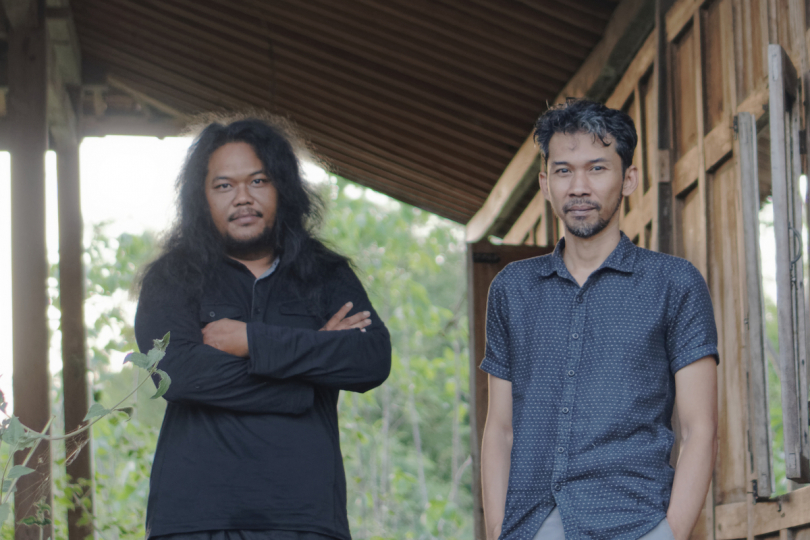
Raja Kirik: Know the Tradition in Order to Destroy It
Raja Kirik is a project created by Yennu Ariendra (musician, electronic composer and sound designer) and J. Mo'ong Santosa Pribadi (composer and instrument maker). Their concept aims to narrate past events related to the Dutch period of the colonisation of Indonesia, combining elements of traditional folk, ancient mythology and trance dance performances. Their gig, during the Lunchmeat Festival in Prague just a few weeks ago, was more of a shamanic experience, rather than a performance. I had a talk with both Mo'ong and Yennu about music, what tradition means to them and why it is necessary to still talk about colonialism today.
First of all, I wanted to ask you something about your name and how your project Raja Kirik was born. How did it all start?
M: We come from independent environments: we work together with music, but we also have individual projects. So, at the beginning of 2018 we met, and had the same vision. You know, we started with the trance dance in Java, but he (Yennu) comes from Eastern Java where there is jaranan buto, and I am from central Java, where I used to watch every day the jathilan, also called jaranan. At that time, we talked about creating something together. Actually, at first, the project we had in our mind was not intended for music, nor for touring or for a band. This was part of a bigger idea, more oriented towards exhibitions or galleries. It was more about narration, starting from the town Blambangan, today called Banyuwangi, in Eastern Java.
In what sense? Is it supposed to be a visual artistic product?
M: Yes, and involving literature as well. What happened now is that we actually became a touring duo, but we never planned on doing that! We never planned to become a band, because we already work independently in that field. You know, Yennu works in music and he is also a composer. I am a composer too, but we have our own projects and that’s the way we met.
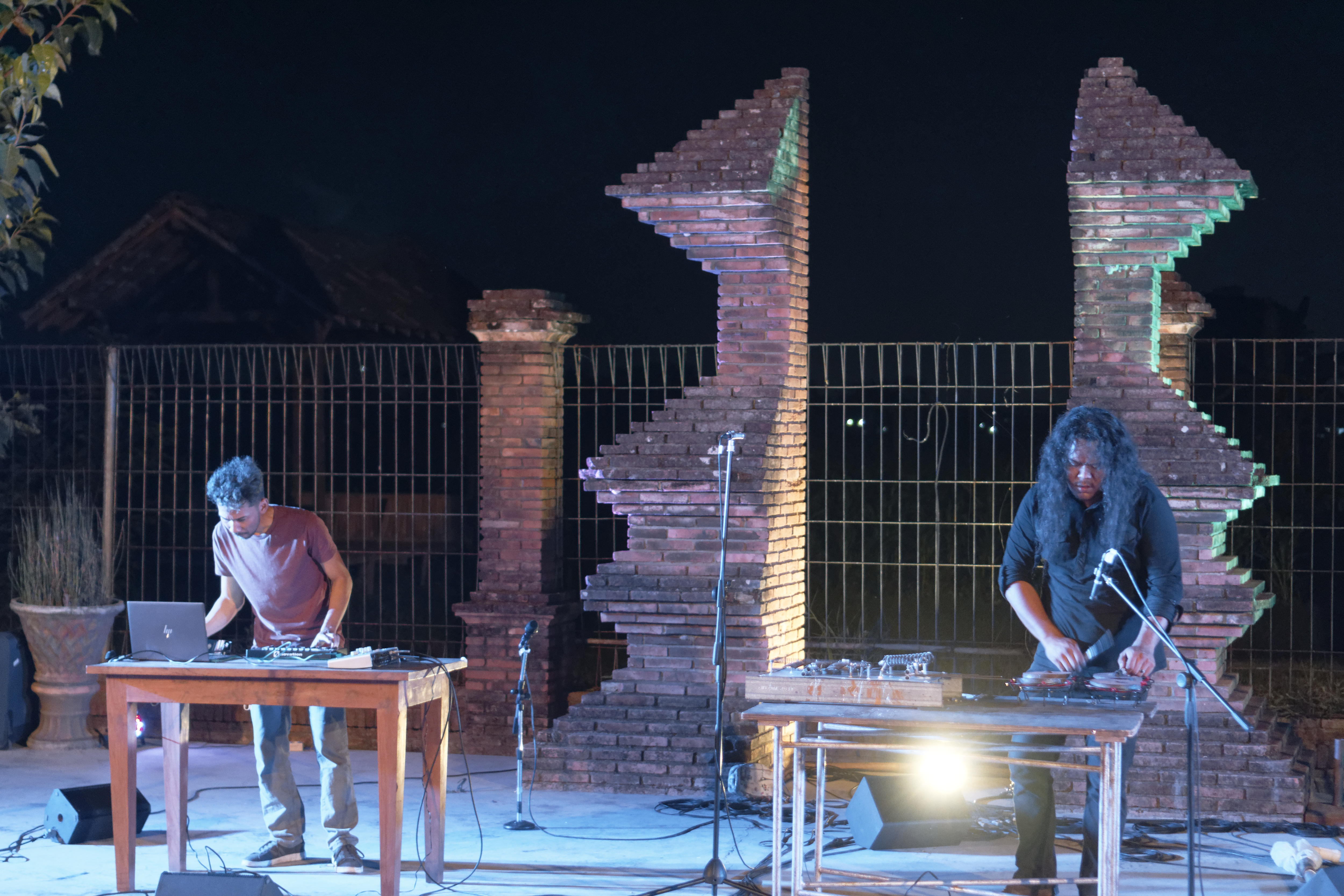
What is the meaning of your name?
Y: It means literally “Dog (Kirik) King (Raja).” In Javanese, we have several words to use for a dog.
M: For example, you can say asu for dog in Indonesian. But asu is more like a powerful dog, a badass one. Kirik is instead a small spoiled little one, powerless and barky.
Y: So, Raja Kirik means “Dog King” in the sense that it is a small king, and nobody cares about him. It is a symbol of rebellion of course. It symbolises the people, and their powerlessness, as if a big king would say to a lesser one: “you can only have a small talk!” (laughs). But there is a deeper meaning in our name. In Eastern Java, we have a long story about the war of Narayan and the rebellion. There was a big kingdom in Java at that time and a smaller area was separated by the kingdom. The rebels, having occupied the smaller area, even after they ultimately lost the war, kept fighting for it. So, there was like a big king of Java and a smaller one. And for the smaller king, they would use appellatives such as “doghead,” for example. Or they claimed that the king was a cannibal, that he was not human, that he was even a demon! Mythology was really important in that time. And people still claim today that there is something dark and demonic going on in Eastern Java, or something like that. But the people from this small area who were defeated portrayed their king as a hero. They tried to alter the narration: “Okay, so he is a demon, but this demon is my king!” And then they created a lot of mythology based on him. So now the symbol of this king became like a cure for the local people, up until today. And also, a lot of art was made based on the myth. We previously mentioned Jaranan Buto, well, he is a horseman, but all the characters are giant, even the horse. Buto stands for giant. Everything involved in the representation is giant. So, they have like giant boars, giant horses and giant knights, something like that.
M: This is at the beginning, but afterwards the myth was connected with a type of dance. And it is all about people power and the resistance that started in East Java. Another example is Reog Ponorogo, which is a mocking dance where the king has a peacock feathered hat and the head of a lion, connected also with Champa (formerly Chinese, today in Vietnamese territory). The peacock is also a Chinese symbol of the woman, it symbolises the wife of the king, a Chinese royal, who actually controls the king. The lion is the king. The peacock above the lion indicates that the king no longer has power, it is a symbol of rebellion.
This is very interesting and curious the way art and myth communicate. How does music work in this context? How does music develop among these myths, for example, or how does music accompany these types of ceremonies?
M: The music basically comes from some elements of gamelan, but it is essentially minimalist. They are just two or three beats and a lot of repetition. And then there is some flute. All this music has almost the same pattern, but every region, every place, has a little bit of modification within their own style. This is the complexity in Java, also. But basically, the pattern is the same, the beat or the rhythm is the same. The most important is the performance itself, the dance itself, because it’s a performance about power. For example, in Jaranan, in Central Java, when people go into a trance, they eat an alive chicken, they eat glass, nails or fire. Close to Bali they also have this performance where they stab themselves with knives or big blades, but there is something similar in central Java as well. There are many hypotheses that try to explain these performances, and sometimes people think it is about showing power; a form of non-aggressive resistance. I would define it as a passive-aggressive soft revolt.
How are people involved in the performance? Is the audience active during the dance? Who goes into the trance?
M: There is a dance, but anybody can join! If you go, you can participate in the performance, be in the dance and maybe you can go into a trance.
Y: To go into a trance, you need to perceive some specific frequencies in your body, which some people do. If you don't have it, you cannot do that.
M: But also, sometimes, when you really open yourself, you know, you will go into a trance.
Y: And there is always the shaman there, in case your state of trance is too extreme, he is going to stop it.
Have you ever experienced the state of trance?
M: Me, when I was a teenager. It's fun, you know? If this performance was brought to Europe, for sure it would be forbidden for the kids to watch it. But in Java it is like culture. It's normal. For us, it’s not cruel.
It is also in your music videos, like Dor and Rampokan. How do European people understand these practices?
M: Yes. So, this is interesting. One time I was talking with some people in Vilnius and they were asking: "How is it that you see the devil as good in Indonesia?" But in Indonesian mythology from Java, the line dividing good and bad is almost invisible. Even devils have a good side. But I come from a Christian family. Yennu is from a Muslim family. My grandfather was one of the first missionaries in Java, but our families believe in this culture.
Y: It is important to establish that in Java or other areas of Indonesia everything that has arrived from the outside has suffered some kind of modification, also religion. And music, of course. Nothing in Indonesia is fixed.
It seems everything is more flexible and it looks like people are open to accepting changes and are, in fact, eager to embrace them. That's why in Indonesia your music might also sound more ordinary when compared with European sounds. And also, your music seems free of canons and classifications, to be more open. Do you have a musical education?
Y: I have never studied musical theory, but I followed the trends of music imported from the West, plus I added some knowledge of traditional music.
M: I studied classical music and music theory at music school, but in fact, I get bored with the rest of the music! Even now, I make a deconstruction of the academic system. Nowadays everybody who wants to study music has to start from the sheet and the partition and notes. I’d say, just play! Have fun, enjoy, and then you will embody the art. Of course, all knowledge, as I had mine in music, is important in your life. But I found my own way. I took from music theory what I needed, and I made It mine.
And what are your influences?
Y: I think we are also lucky, as musicians coming from Indonesia. We know our culture well, but we also have this Western music knowledge. And we try to learn from everything. I try a lot of digital stuff. We try to speak about our culture, while at the same time using different influences, inserting some noise or even using hardcore sounds, for example.
M: We always combine. I learnt the basics and classical music at school, but then I found the way to create music. What I don't like is the system, but not the knowledge. In Raja Kirik we have a polyrhythm…
Y:…a chaos-rhythm!
M:...which is not really Javanese, it has some Western influences.
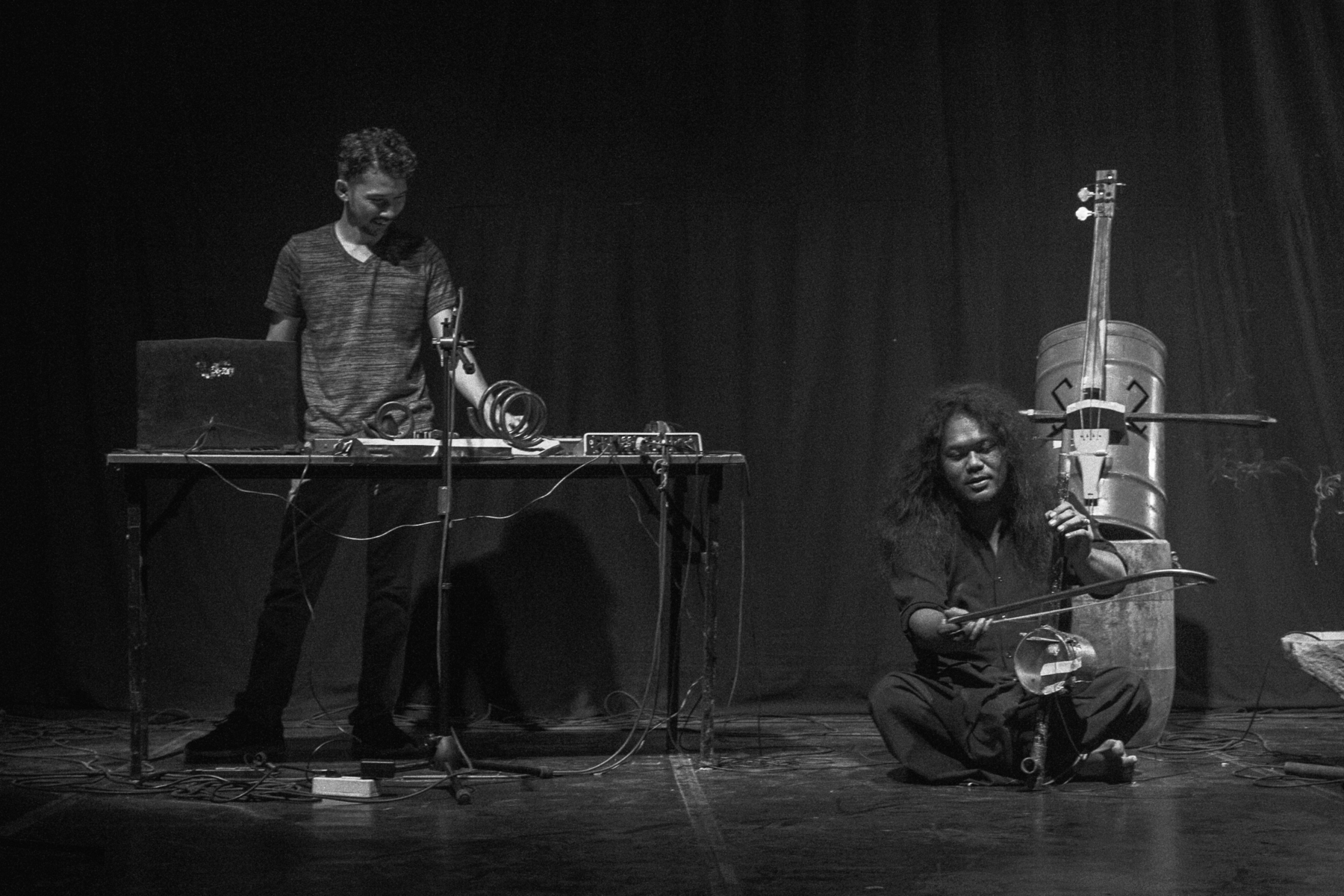
What's your creative process? How do you start creating music?
M: Our second album was recorded remotely. We were staying far from each other and it was during the pandemic. But our creative process usually goes like this: Yennu creates a musical structure, he sends it to me, I add some new layer, I send it back to him, and so on, back and so forth.
Y: We don’t think about what we are making when we are making it. But the sure thing is that we keep in our mind the trance dance. And that is also the reason why Mo’ong uses garbage, literally garbage for playing music. Because this trance music usually happens in the outer areas, not in the capital cities.
M: And that is also how it became a form of resistance, as opposed to what happens inside of the palace. And the music is played with cheap tools, by people who do not have much money to buy instruments. I use objects from trash also as a criticism towards the utilisation of musical instruments in the gamelan orchestra, the “palace” way. And also as a form of resistance, not in terms of sustainability though, symbolising in fact opposition to the traditional gamelan and institutional music.
Y: We have a very complex society. The palace art or palace gamelan is like an institution. It is already fixed. It is performed at some special occasions, and the audience comes from the higher class or even the Royal family.
M: Also, in gamelan, they put some mythology, for example, they say that instruments have spirits. But I want to destroy that. And there is also another difference between Indonesia and the Western world. Everybody (in the West, ed.) talks about freedom, and they claim they can express everything. But in Indonesia, especially in Java, when you're talking about freedom, it doesn’t mean “do whatever you want!” We have to understand the context because we have a really strong culture. So actually, that's what makes artists more creative there, how you have to work in synergy with the artistic concept that already exists there. But we also have both sides, with some strong alternative communities that want to go against the usual kind of thing.
The use of certain “crooked” instruments coming from garbage certainly does embody this approach…
M: Yeah. Because with this instrument, even if I play in a gamelan style, ultimately, I can play whatever I want. And people from the conservatory, institutes or during the conventions, they will not be angry at me because it's not gamelan, “but it sounds like gamelan!” But I can answer “But it’s not gamelan!” I want to express freedom, but I have to create something. So, we can still keep it like “let them exist, and then let us also do something. So that's why in Indonesia, where there are some influences, especially in Java—Muslims, Christians, Dutch colonists—they cannot change the status quo. For this reason, you can still find the roots, even if the flow changes, carrying with it a lot of influences. You still can find them.
This is probably one big difference in comparison to Europe, where many artists, when trying to do something revolutionary, sometimes do something completely alienated. And maybe it's wrong because you said you need to acknowledge the tradition and the culture to eventually destroy it, to fight it…
M: Because we also need to respect them and accept that they exist. It’s the same, also, when we're talking about the concept of democracy. Why do you have to say: “You are wrong. I'm the right one.”? Because you never know. Okay. Do whatever you want. If you're talking about the real democracy. So, the democratic system for me is this and, in reality, we never talk about the core of democracy, but we lean on a system that's present in communities. Is it democratic, or not? In the end, it’s just the way it is.
What’s the other face of the medal? Is there social friction?
M: I mean, of course, we still have a problem with tolerance, with everything like that. But basically, we grew up in diversity. Many diverse people with a lot of differences. We have different religions and forms of spiritualism, we have so many languages, we have infinite national holidays: Chinese New Year, Indus, Buddhists, Christians and Javanese holidays… in Europe, only Christmas! (laughs)
Y: In Bali there are plenty of national holidays.

How would you describe your music, if there is a way to do so?
(both laugh)
M: Basically, it’s trance. All the ideas come from there.
Y.: Even though I like to use a hardcore beat, for example, I use it as a trance beat.
M: Or we use the typical rhythm of gamelan, but of course, it is not typical for trance music. But at the same time, it cannot be classified as “traditional.”
Y: It’s rather contemporary.
M: What exactly is “traditional?” It might be a different perspective from the West, but for example, the trance dance people call it “traditional dance.” But actually, the way we see it, it’s really contemporary. If you see the shadow puppets in Java, Wayang, yes, of course, it looks traditional now because this is coming from tradition, but it has already changed and become modern and contemporary.
Y: We have the Conservatory, and that we call traditional, or like the palace gamelan, that’s traditional. Because that stopped. It’s already fixed. But if you see the trance dance right now in the village, maybe they will use even a DJ or something like that, or midi or electronic keyboards.
How did you start doing music? What first got your interest in music? At which moment in your life, did you decide to be a musician?
M: Since I was a kid, I wanted to be a musician! I first actually started with painting. I finished elementary school. I wanted to play music.
Y: Everything started for me because I was basically traumatised by a trance dancer. Maybe I was 4 years old. He was chasing me, I think. I was little, and I ran away because he had a lot of blood in his mouth, because he had bitten an alive chicken, and then he started chasing me. But that's maybe why I fell in love with jaranan, because I have acknowledged it, and I was being chased and basically, I had this whole intense experience in that moment. I realised I wanted to be an artist.
Did you have any inspirational models? What were you listening to, and what music inspired you to make music?
M: I listen to everything. But mostly Indonesian “traditional” music, you know. I mean, I don't have really specific artists, which are my favourite. But I listen. I don’t choose a particular artist to be a fanatic about. I just listen randomly to something. I can listen to metal, pop, rock, love songs or classical music. I don’t prefer any particular genre.
Really, nobody in particular?
M: For example, from Indonesia, I listen to the composer Rahayu Supanggah, who’s also my teacher. And from the West some minimalist composers, like Phillip Glass or Steve Reich. Also, another trumpet guy, Jon Hassell: I was interested in him because he made a record about Malaya and Java surrealism. So actually, I listen to analyse, rather than to enjoy! Mostly our generation in Indonesia tends not to be fanatic about a specific artist or follow narrow trends. If I am in the mood for classical music, then I listen to classical music.
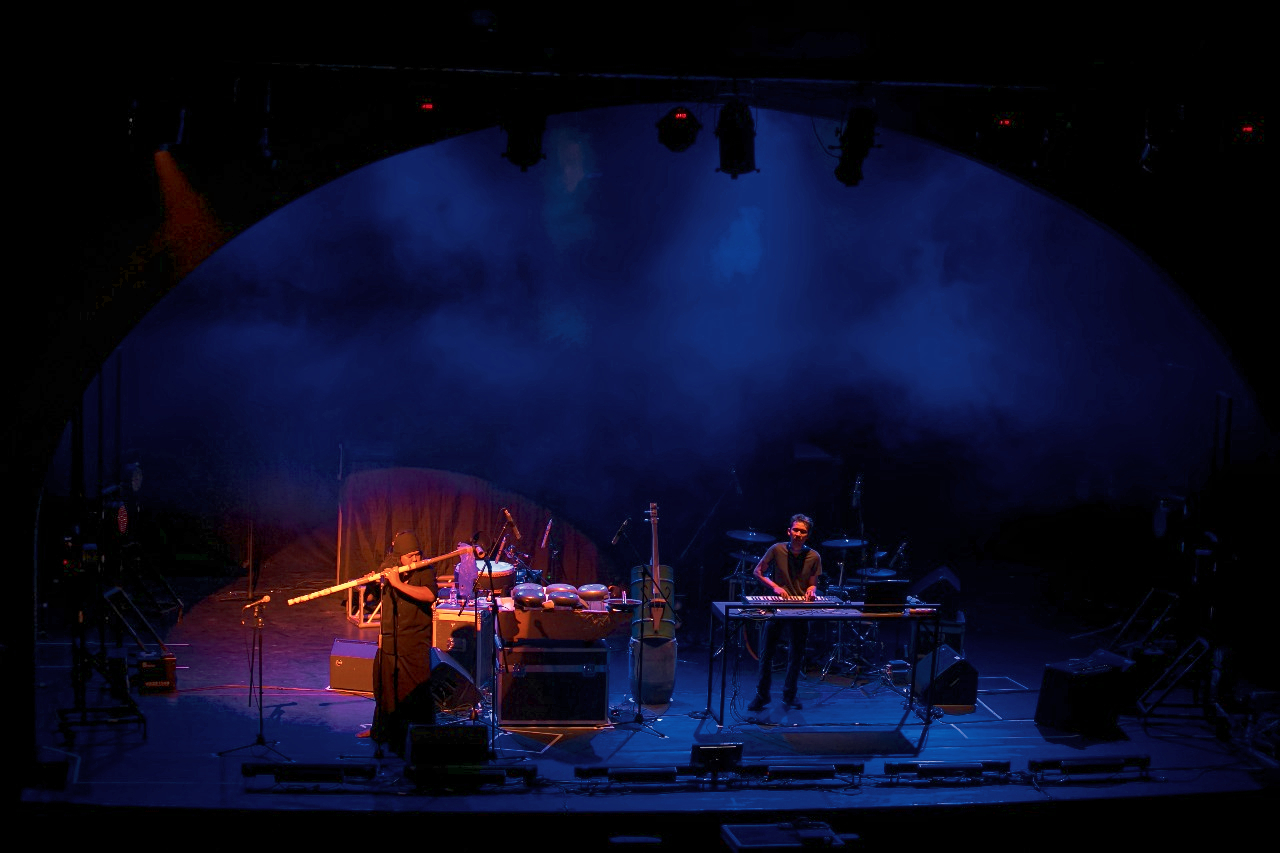
And do you listen to music together sometimes?
M: When we do some research! (laughs) We listen to dangdut, for example (Indonesian dance folk, ed.)
Y: And it is impossible not to listen to sounds. Indonesia is a very noisy country. In the morning, for example, your neighbour might play dangdut super loud, and there are also a lot of public prayers.
M: When you are born in Indonesia, then naturally you will hear a lot of things. Noise itself. You know, noises can be everything, a motorbike, the moths, some animal, and every night until now you still can hear gamelan or wayang music coming from the villages, where there are still many bands playing this music.
Y: 24-hours of noise music everywhere!
Are there many bands or artists nowadays in Indonesia?
Y: I mean, in my neighbourhood like two or three jathilan/trance dance groups and maybe two dangdut groups. There are a lot of local music activities.
Is it easy to work as a musician in Indonesia?
Y: I spent a lot of time in the alternative scene, but I don’t expect money from there. But I'm working in the music industry. So, I am scoring for movies and commercials and that is how I can live.
M: Not really. Depends. You need to work hard on it but also get lucky. I consider myself quite lucky to have had the chance to make a living by being a musician. But of course, the process was long and it continues to be. I also work for the theatre, dance performances, documentaries, and scoring, a little bit like Yennu, but he’s more into the industry, I am more underground. But we almost have the same kind of job.
Have you worked together before?
M: We worked with one company, but depending on projects, sometimes I'm working on one, and sometimes he does another. We will work together with the theatre in Utrecht this summer, but using our names, not under Raja Kirik. When we became Raja Kirik we didn’t expect to be touring or getting known so much. We had nothing to lose!
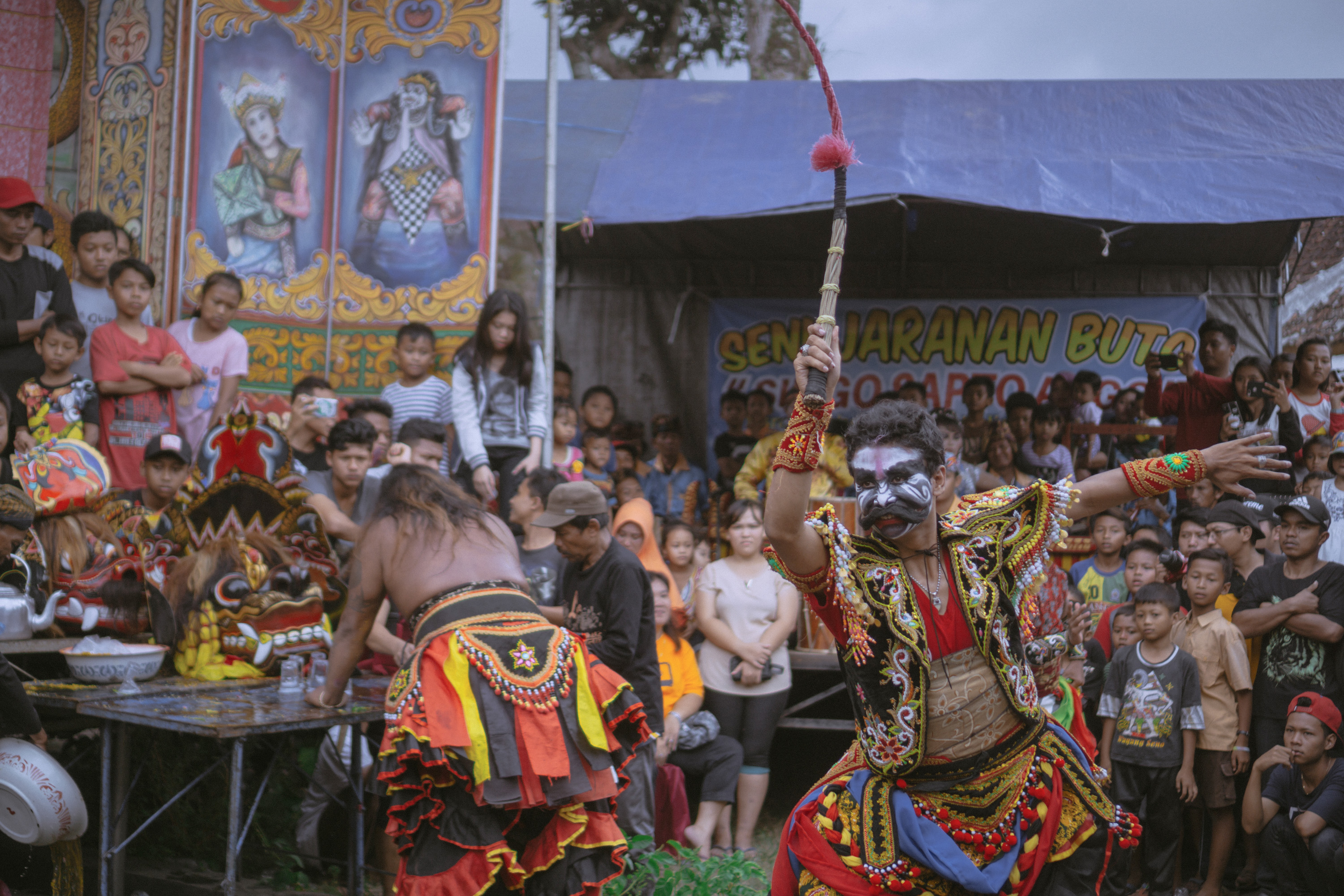
Are there other bands playing the same genre as yours, in Indonesia?
M: There is a starting point with this scene abroad and it is Senyawa. It was the first to export this type of music to Europe and the world. And then luckily Raja Kirik and Gabber Modus Operandi came. And now all of us have become role models for the new generation, who try to emulate us, I see it also on Instagram. But this is the process. But at the same time, I think, “just make something else, you know, of course you cannot make the same.”
Y: I guess you can have a lot of ideas, you can work from anywhere and contact basically anybody, nowadays.
Would you like to collaborate with some artists?
M: We are open to it. As individual artists, we receive many requests for collaboration, but not many as Raja Kirik, probably due to the fact that the project is quite young.
Y: That’s also why we brought Raja Kirik to the theatre, for example. We will work with a Singaporean director based in Berlin, Choy ka Fai, on a show during the spring festival in Utrecht, with dancers from Amsterdam.
Are you planning a new record?
M: Probably not an album, but we talked about this, our idea is we want to make some special edition record, featuring musicians from the East of Java and afterwards put together four big theatre shows, hopefully in Europe. In Indonesia, we don’t get much funding for shows, but when the director is European and takes our stories to Europe, he is praised. Let us this time, instead, show our own to you!
If you have found an error or typo in the article, please let us know by e-mail info@insounder.org.

